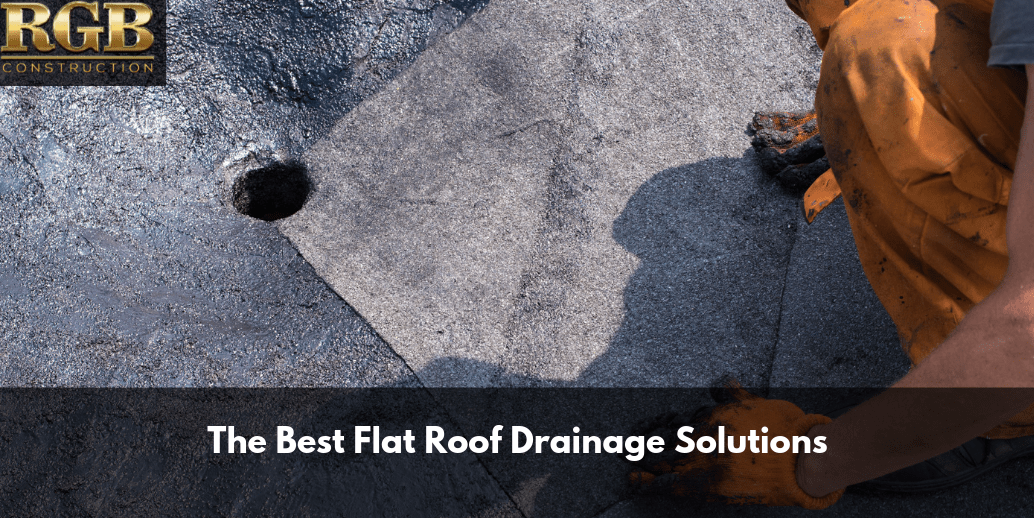You’ve undoubtedly wondered, why are so many commercial buildings flat-roofed in an area where rainfall is commonplace? It seems like a counterintuitive idea, given pitched roofs are pitched precisely for the purpose of sloughing off snow, ice, and rain. And yet, almost all commercial buildings of any real size, anywhere in the world, is flat.
What’s going on here? The fact of the matter is, pitched roofs are not practical for gigantic structures. They’re costly, they’re maintenance nightmares, and they present climate control and safety problems that would drive anyone mad.
There is a little secret to these flat roofs, though, that makes the rain far less of an issue than one would expect. There’s quite a lot of science to flat roof water drainage systems. Flat roofs aren’t truly perfectly flat, for one thing. There’s actually a grade present, causing water to flow away toward the fringes of the roof, where it’s hopefully drained away efficiently.
The right flat roof drainage design makes or breaks the practicality of a flat roof, though, and there are indeed a few methods that can be implemented. They all have their merits, and their issues. It’s time to look at the three most common drainage systems for flat roofs, and the consequences of choosing poorly.
The Consequences of Poor Drainage
First, let’s talk about what happens when your drainage doesn’t work right. Water will pool on your roof, which leads to added stress on the structure, and eventually, water damage will occur. Not unlike with residential locations, black mold and water damage are truly sinister things, and code enforcement is quite a bit less forgiving in the addressing of these issues with commercial structures, as well.
Ice can also form, which can make any rooftop maintenance hazardous, and can cause your roofing material to become brittle, or really add a lot of stress to the structure, which could ultimately cost lives. Lastly, detritus like leaves, twigs, airborne garbage, animal waste and pests can accumulate on a roof that doesn’t drain well, and any number of problems can arise from these.
We can see why this drainage is important, but what are our choices when it comes to flat roof drainage design? Let’s take a look now.
Gutter Systems
A flat roof gutter is honestly the same concept as gutters on pitched roofs. A trough encompasses the structure, and the water runs off into it, and is then disposed of via downspouts at one or more locations.
This is going to be one of the more common approaches for residential flat roof designs, rare as such things are in rainy locales. Gutter systems are one of the more affordable approaches, but they of course have the same issues as a gutter system on a pitched roof.
Pros
- These are easy to fix if they become clogged.
- These are affordable, and replacing damaged components is trivial.
- They have physics on their side, making them efficient when they’re not blocked up.
Cons
- Gutters are easily damaged by winter weather, and things like ice dams are a problem.
- Gutters clog easily, as any homeowner weary of cleaning their gutters can attest to.
- It doesn’t look fantastic, and aesthetics do matter.
Interior Drainage
This is the most common approach to flat roof drainage, but the expense of it, as well as the maintenance headaches when something does go wrong, make these a poor choice for residential solutions, generally speaking.
Interior drainage uses apertures along the fringes of the roof, which drain through pipes contained in the walls, draining either into the sewage system, or from outlets near the foundation of the structure.
Pros
- These protect your foundation, landscaping, etc. the best.
- They’re hidden, meaning no aesthetic compromises are necessary.
- The materials are often sturdy, and these tend not to block as often as gutters.
- This kind of system can increase rent value or resale value, depending.
Cons
- If they clog, and the pipe needs to be removed, walls often have to be torn into.
- It’s an expensive system.
- If a leak should occur, you can expect horrible water damage in your walls, and possible electrical hazards.
- In nature-heavy areas, animals have a bad habit of getting into these and dying, or clogging them with nests.
Scuppers
Lastly, we come to scuppers, which are kind of a compromise. Scuppers are openings along the border of the roof, which allow water to simply pour out through wide, open pipes. If placed properly, they’re not very visible, so there’s little aesthetic compromise. In fact, with some designs, they can almost look ornate (see southwestern pueblo-style architecture for an example).
Scuppers may simply pour out to the ground, or they may have downspouts placed to catch the water, and lead it away from landscaping and the foundation. These are the other most common solution for residential flat roof drains.
Pros
- Scuppers almost never clog.
- Scuppers don’t form ice dams or other winter problems.
- Scuppers are affordable, low-maintenance concepts.
Cons
- Scuppers have to be placed wisely, so to not douse landscaping, vehicles, or visitors.
- Without a downspout, they can cause swampy puddles that ruin grass and cause erosion.
- Scuppers that aren’t installed with a lot of care, can weaken the façade around the roof.
To learn more about flat roofs, roof drainage and all things roofing, fill out our contact form today!







